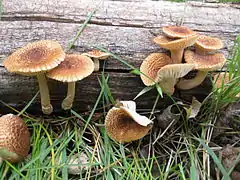| Heliocybe | |
|---|---|
 | |
| Heliocybe sulcata | |
| Scientific classification | |
| Kingdom: | |
| Division: | |
| Class: | |
| Order: | |
| Family: | |
| Genus: | Heliocybe Redhead & Ginns (1985) |
| Type species | |
| Heliocybe sulcata (Berk.) Redhead & Ginns (1985) | |
Heliocybe is an agaric genus[1] closely allied to Neolentinus and the bracket fungus, Gloeophyllum, all of which cause brown rot of wood.[2][3] Heliocybe sulcata, the type and sole species, is characterized by thumb-sized, tough, revivable, often dried, mushroom fruitbodies, with a tanned symmetric pileus that is radially cracked into a cartoon sun-like pattern of arranged scales and ridges, distant serrated lamellae, and a scaly central stipe. Microscopically it differs from Neolentinus by the absence of clamp connections. Like Neolentinus, it produces abundant, conspicuous pleurocystidia. Heliocybe sulcata typically fruits on decorticated, sun-dried and cracked wood, such as fence posts and rails, vineyard trellises in Europe, branches in slash areas, and semi-arid areas such on sagebrush or on naio branches in rain shadow areas of Hawaii, or in open pine forests.[4][5][6][7]
Etymology
Heliocybe derives from the Greek helios (= the sun) and cybe (=head), and means "the sun-head". It was coined in reference to its sun-like pattern on its pileus together with its affinity to sun-baked habitats.
Classification
In older classifications, H. sulcata was known as Lentinus sulcatus or Panus fulvidus. However, there is strong phylogenetic evidence for the segregation of a group of brown rot causing fungi at the level of order, including Neolentinus and Heliocybe and Gloeophyllum, from the Polyporales where Lentinus and Panus are classified.[2][3][8][9][10] Heliocybe has also been placed into synonymy with Neolentinus, but anatomically they differ by the absence versus the presence of clamp connections[1] and phylogenetically Heliocybe is distinct, being either a sister group to Neolentinus or to a Neolentinus-Gloeophyllum-clade, or allied to Gloeophyllum odoratum.[2][3][9][10]
References
- 1 2 Redhead, S.A.; Ginns, J.H. (1985). "A reappraisal of agaric genera associated with brown rots of wood". Trans. Mycol. Soc. Japan. 26: 349–381.
- 1 2 3 Thorn, R.G.; et al. (2000). "Phylogenetic analyses and the distribution of nematophagy support monophyletic Pleurotaceae within the polyphyletic pleurotoid-lentinoid fungi". Mycologia. Mycologia, Vol. 92, No. 2. 92 (2): 241–252. doi:10.2307/3761557. JSTOR 3761557.
- 1 2 3 Hibbett, D.S.; Donoghue, M.J. (2001). "Analysis of character correlations among wood decay mechanisms, mating systems, and substrate ranges in Homobasidiomycetes". Syst. Biol. 50 (2): 215–242. doi:10.1080/10635150151125879. PMID 12116929.
- ↑ Redhead, S.A. (1989). "A biogeographical overview of the Canadian mushroom flora". Can. J. Bot. 67 (10): 3003–3062. doi:10.1139/b89-384.
- ↑ Schalkwijk-Barendsen, H.M.E. (1991). "Mushrooms of western Canada".
{{cite journal}}: Cite journal requires|journal=(help) - ↑ Evenson, V.S. (1997). "Mushrooms of Colorado and the southern Rocky Mountains".
{{cite journal}}: Cite journal requires|journal=(help) - ↑ Hemmes, D.E.; Desjardin, D.E. (2002). "An identification guide – mushrooms of Hawai'i".
{{cite journal}}: Cite journal requires|journal=(help) - ↑ Hibbett, D.S.; Binder, M. (2002). "Evolution of complex fruiting-body morphologies in homobasidiomycetes". Proc. R. Soc. Lond. B. 269 (1504): 1963–1969. doi:10.1098/rspb.2002.2123. PMC 1691125. PMID 12396494.
- 1 2 Binder, M.; et al. (2005). "The phylogenetic distribution of resupinate forms across the major clades of mushroom-forming fungi (Homobasidiomycetes)". Syst. Biodivers. 3 (2): 113–157. doi:10.1017/S1477200005001623. S2CID 13102957.
- 1 2 García-Sandoval R; Wang Z; Binder M; Hibbett DS. (2011). "Molecular phylogenetics of the Gloeophyllales and relative ages of clades of Agaricomycotina producing a brown rot". Mycologia. 103 (3): 510–524. doi:10.3852/10-209. PMID 21186327. S2CID 9801943.